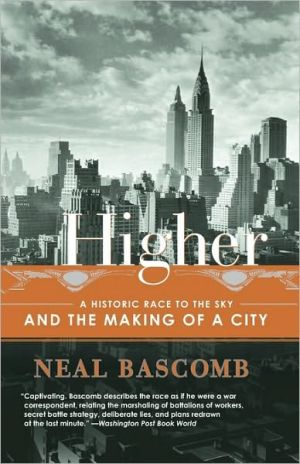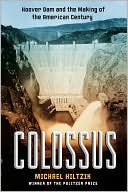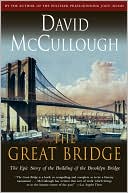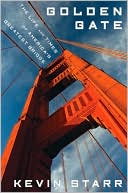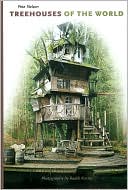Higher: A Historic Race to the Sky and the Making of a City
In 1924, in the vibrant heart of Manhattan, a fierce rivalry was born. Two architects, William Van Alen and Craig Severance (former friends and successful partners, but now bitter adversaries), set out to imprint their individual marks on the greatest canvas in the world -- the rapidly evolving skyline of New York City. Each man desired to build the city's tallest building. Each would stop at nothing to outdo his rival. Van Alen was a creative genius who envisioned a bold, contemporary...
Search in google:
The Roaring Twenties in New York was a time of exuberant ambition, free-flowing optimism, an explosion of artistic expression in the age of Prohibition. New York was the city that embodied the spirit and strength of a newly powerful America. In 1924, in the vibrant heart of Manhattan, a fierce rivalry was born. Two architects, William Van Alen and Craig Severance (former friends and successful partners, but now bitter adversaries), set out to imprint their individual marks on the greatest canvas in the world—the rapidly evolving skyline of New York City. Each man desired to build the city’s tallest building, or ‘skyscraper.’ Each would stop at nothing to outdo his rival.Van Alen was a creative genius who envisioned a bold, contemporary building that would move beyond the tired architecture of the previous century. By a stroke of good fortune he found a larger-than-life patron in automobile magnate Walter Chrysler, and they set out to build the legendary Chrysler building. Severance, by comparison, was a brilliant businessman, and he tapped his circle of downtown, old-money investors to begin construction on the Manhattan Company Building at 40 Wall Street. From ground-breaking to bricklaying, Van Alen and Severance fought a cunning duel of wills. Each man was forced to revamp his architectural design in an attempt to push higher, to overcome his rival in mid-construction, as the structures rose, floor by floor, in record time. Yet just as the battle was underway, a third party entered the arena and announced plans to build an even larger building. This project would be overseen by one of Chrysler’s principal rivals—a representative of the General Motors group—and the building ultimately became known as The Empire State Building.Infused with narrative thrills and perfectly rendered historical and engineering detail, Higher brings to life a sensational episode in American history. Author Neal Bascomb interweaves characters such as Al Smith and Governor Franklin Delano Roosevelt, leading up to an astonishing climax that illustrates one of the most ingenious (and secret) architectural achievements of all time.The Washington PostBascomb is at his best situating his drama in a city and a nation on the cusp of greatness but also on the verge of financial collapse. Plans for the glorious landmarks were begun in an era of dizzying financial achievements, but they were finished after the 1929 crash, as capital vanished and demand for office space disappeared. — Grace Lichtenstein
PROLOGUE\ The Soaring Twenties
Prologue: The Soaring Twenties1Part 1Chapter 1A Hunch, Then a Demand17Chapter 2The Architect-Artist32Chapter 3A Proud and Soaring Thing46Chapter 4The Organization Man59Chapter 5Make the Land Pay72Chapter 6An American Invention91Chapter 7The Poet in Overalls101Chapter 8To Scrape the Sky116Chapter 9Equivalent to War130Chapter 10A Three-way Race139Interlude: Oxygen to the Fire155Part 2Chapter 11Call It a "Vertex"163Chapter 12A Monument to the Future178Chapter 13The Prize of the Race190Chapter 14The Butterfly and Its Cocoon199Chapter 15Crash213Chapter 16Pharaoh Against Pharaoh228Chapter 17Aladdin's Genii and Paper Fights241Chapter 18The Chase into the Sky254Chapter 19Excelsior263Epilogue: Spirit--Not Steel and Stone273Acknowledgments290Notes294Bibliography325
\ From Barnes & NobleBarnes & Noble Discover Great New Writers\ At the tail end of the 1920s, the Jazz Age was in full swing, and Americans experienced an unprecedented level of prosperity with no apparent end in sight. Though the Great Depression would soon wipe out many of those gains, three landmark buildings on the New York City skyline -- the Chrysler Building, the Empire State Building, and the Manhattan Company Building -- remain as tangible reminders of the enormous ambition and exuberance that characterized the era. Neal Bascomb expertly re-creates the stories of the men behind the building of these historic skyscrapers, all of whom were racing to make theirs the tallest in the world at the time, like 20th-century pharaohs competing for glory. \ Bascomb profiles business and political leaders as Walter Chrysler, Al Smith, and FDR. But even more compelling is Bascomb's exploration of the long-simmering rivalry between William Van Allen and Craig Severance, former architectural partners who become locked in a captivating battle of deception and intrigue in order to eclipse the height of the Eiffel Tower and claim for their own creation the title of "world's tallest building." Through the fascinating biography of the buildings and the men whose singular vision and drive brought them to reality, Higher -- not unlike Laura Hillenbrand's Seabiscuit -- ultimately tells the story of the character and the spirit of 20th-century America. (Winter/Spring 2004 Selection)\ \ \ \ \ \ The Washington PostBascomb is at his best situating his drama in a city and a nation on the cusp of greatness but also on the verge of financial collapse. Plans for the glorious landmarks were begun in an era of dizzying financial achievements, but they were finished after the 1929 crash, as capital vanished and demand for office space disappeared. — Grace Lichtenstein\ \ \ Publishers WeeklyThe 1920s "race" to build the world's tallest building has been extensively chronicled. A former literary agent and former St. Martin's editor, Bascomb centers his narrative on two architects, William Van Alen and Craig Severance, who schemed to outdo each other in the race to pierce New York City's skies with, respectively, the Manhattan Company Building at 40 Wall Street and the Chrysler Building on East 42nd Street-only to be beaten by a third team hired to construct the Empire State Building (at Fifth Avenue and 34th). While this story is most often told as a sentimental paean to "progress" rather than a bitter corporate feud, Bascomb gives his tale a fresh sense of capitalist drama in his evocation of the nascent worlds of skyscraper engineering, architecture and construction-and real estate speculation with returns projected at 10%. He imbues the former three with some terrific detail (including a 22-item list of how many trades, including mail chute installers and asbestos insulators, it took to build a skyscraper) that gives context to the players and incidental characters, including the five Starrett brothers (builders raised in Lawrence, Kans., who built 40 Wall Street), General Motors' financier John Jacob Raskob (the man behind the ESB), Walter Chrysler, New Yorker reviewer "T-Square," former governor Al Smith and many others. The occasionally intrusive clich s (the Starrett brothers "had building in their blood"), hyperbole (the '20s were "a decade gone mad") and familiar generalizations (the U.S. "finally came into its own" in that same decade) are excusable in a debut book, especially one chronicling an obsession with height and speed. Copyright 2003 Reed Business Information.\ \ \ \ \ Library JournalIt is a pity that this book had to wait till October for publication, as the publishers have missed out on a blockbuster of a summer read. Bascomb, an editor and agent in book publishing, brings a keen eye for fascinating detail to this architectural history and uses an active, engaging writing style to pull the reader along at a rapid pace. The major story is about the battle between two prominent architects, former friends and now professional rivals, Craig Severance and William Van Alen. Severance, a man with "classic" tastes and financed with "old money," draws the plans for the Manhattan Company Building and fights for his formal design to dominate the skyline of New York City. Van Alen, a man with bolder, more "modern" tastes, finds his ideal patron in Walter Chrysler, draws out his plans, and builds a more contemporary, soaring skyscraper. In the background, yet no less important, are the numerous stories of the construction workers, the frenetic press, and major politicians Al Smith and Gov. Franklin Roosevelt, all caught up in the frenzy of this monumental race. While readers will learn much about New York history, skyscraper architecture, and the power and importance of moneyed patronage, this reviewer is not proud to state that the greater joy came from being a witness to a race that determined who will dominate the world's most famous skyline. Recommended for public libraries.-Glenn Masuchika, Rockwell Collins Information Ctr., Cedar Rapids, IA Copyright 2003 Reed Business Information.\ \ \ \ \ Kirkus ReviewsBascomb debuts with a lively account of how three great New York City skyscrapers were built at the end of the Roaring Twenties. The author begins with portraits of two architects, William Van Alen and Craig Severence, former partners who became bitter rivals. Van Alen was the partnership’s creative heart, trained in Paris and imbued with the modernist spirit. Severence was the consummate businessman, constantly networking in search of the next big commission. Breaking up in 1924, just as the skyscraper was becoming the symbol of preeminence in business and the economy seemed to be on an endless upward spiral, the erstwhile friends by 1929 were executing rival commissions to build the tallest building in the world. Severence’s backers were Old Money, with conservative tastes and a building plot at 40 Wall Street, at the center of the financial district. Van Alen’s patron was self-made automobile tycoon Walter Chrysler, willing to spend whatever it took to erect his personal monument at 42nd and Lexington. The two architects openly sought the "world's highest" crown, each altering their designs several times in order to top the other. In the end, Chrysler and Van Alen won. But neither had taken into account the plans of John J. Raskob, who headed a corporation with defeated presidential candidate Al Smith as its spokesman. One of Chrysler’s fiercest rivals, Raskob acquired the Fifth Avenue site of the Waldorf Astoria for a skyscraper destined to become the epitome of its kind: the Empire State Building, completed in 1931. Bascomb puts all three projects vividly in context, giving broad overviews of the times as well as detailed portraits of the men who designed, financed, and constructedthe three buildings even as the crash of 1929 took all the sweetness out of their triumphs. Despite occasionally clumsy exposition, Higher goes a long way toward doing justice to its fascinating subject.\ \
